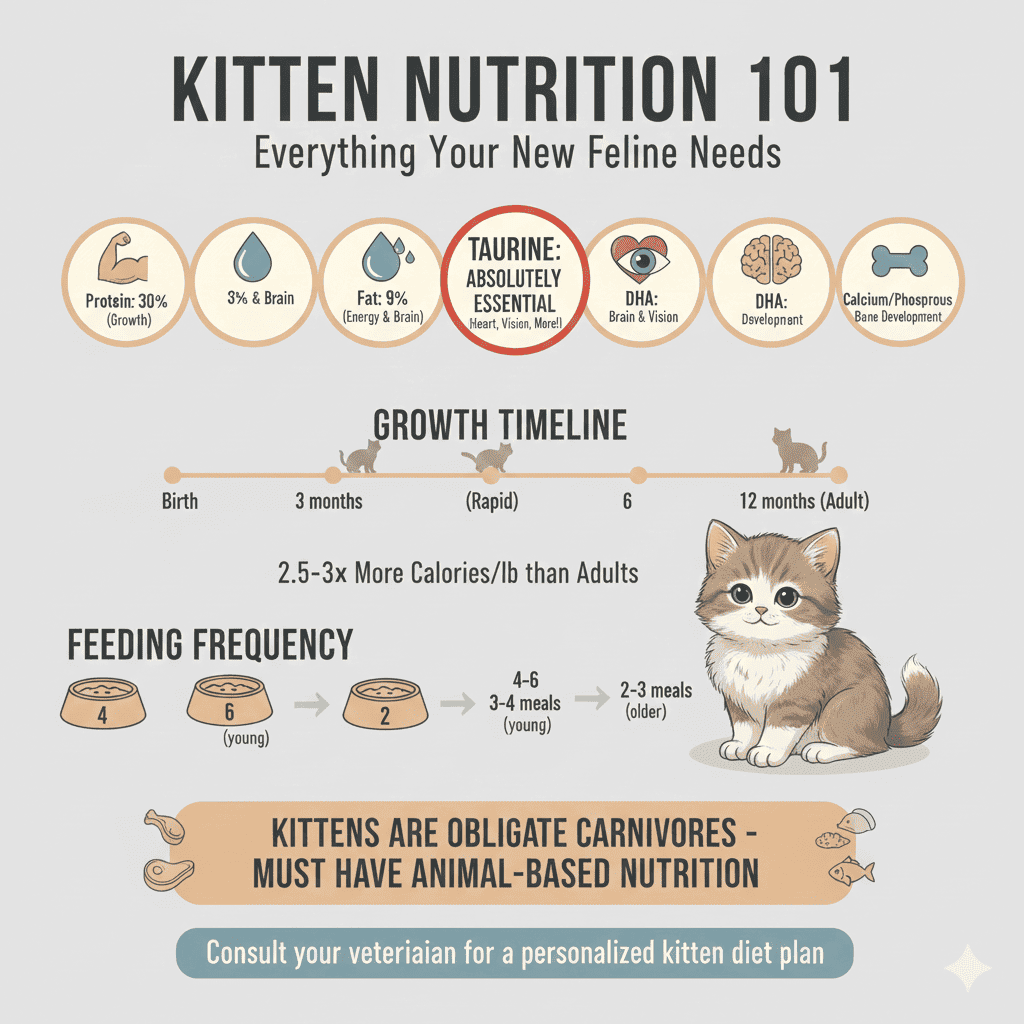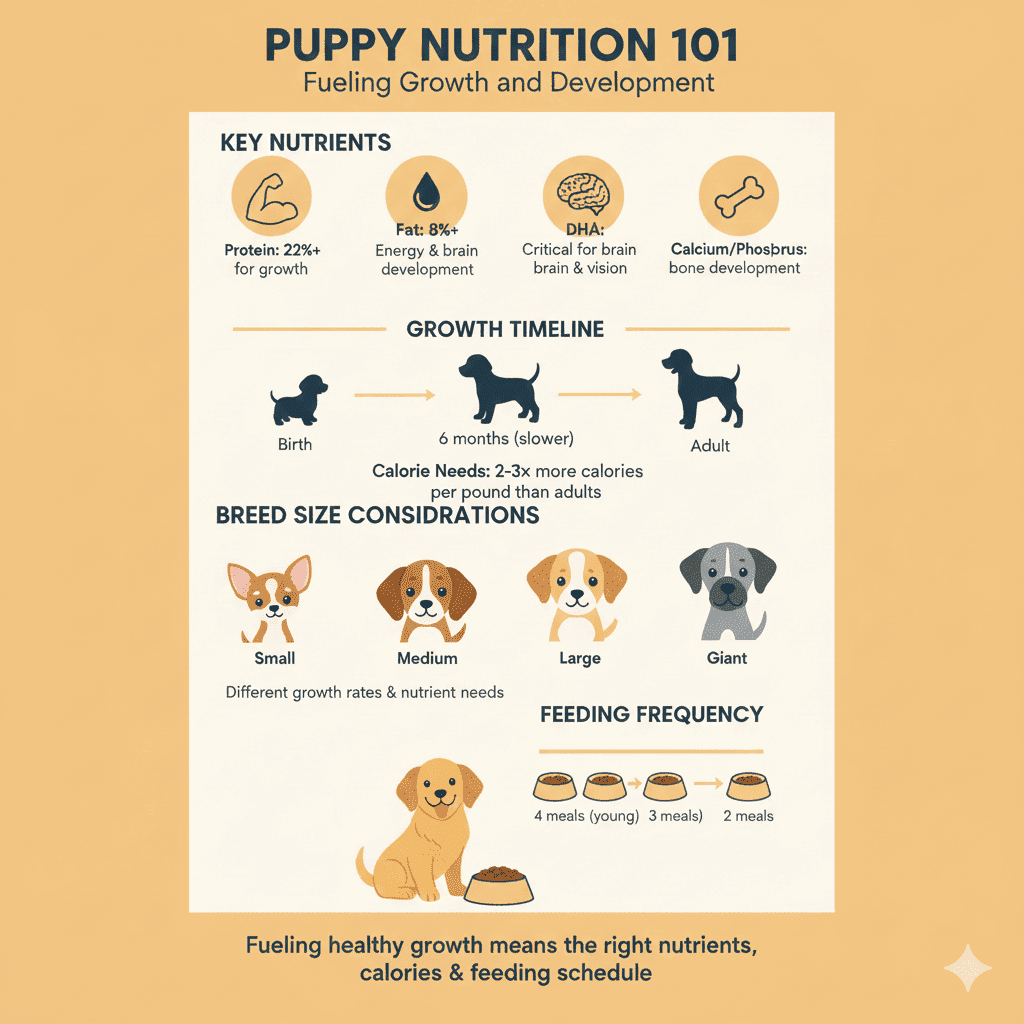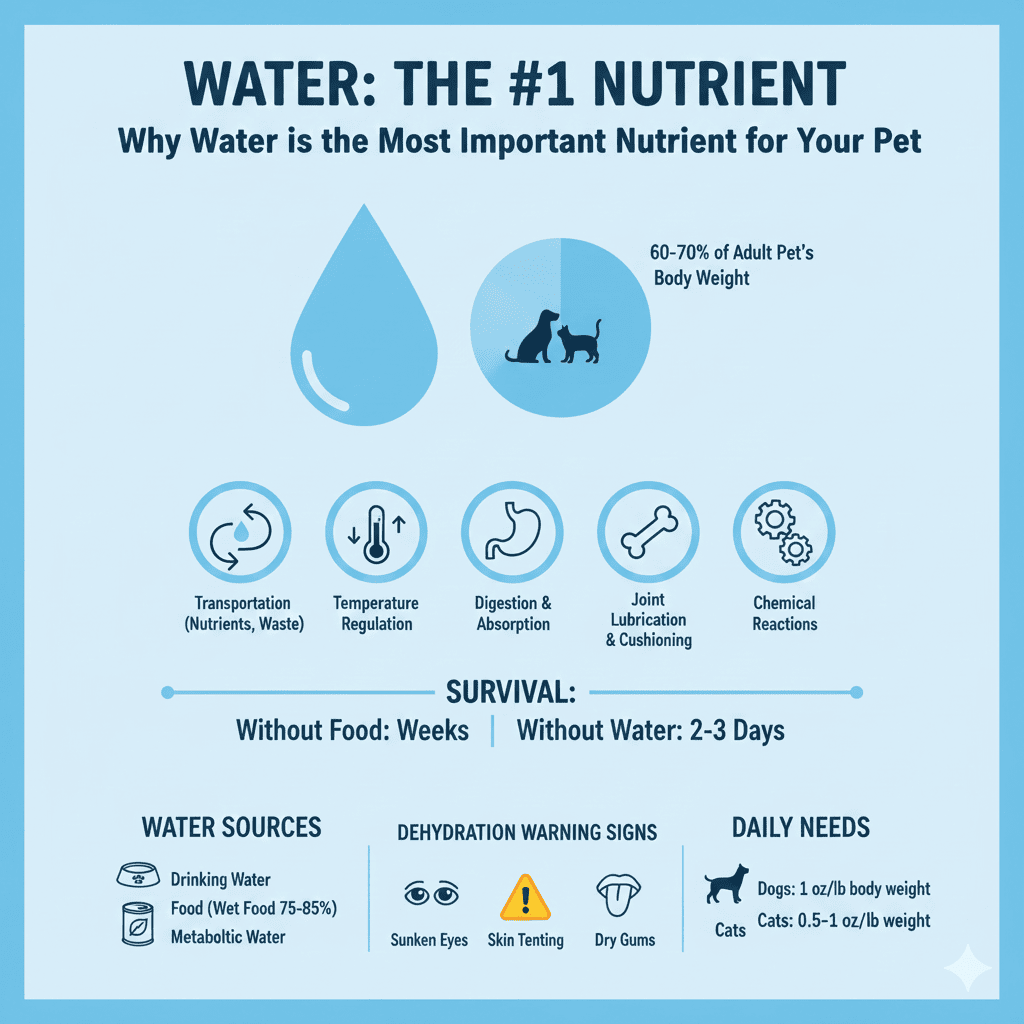Your tiny kitten is about to undergo one of the most rapid growth phases in the animal kingdom. In just their first year, they'll grow from a few ounces to their full adult size—a transformation that requires precise, specialized nutrition.
Kitten nutrition is not just "cat food in smaller portions." It's a completely different nutritional profile designed to support explosive growth, brain development, and the foundation of lifelong health. Getting it right during these critical months sets your cat up for a healthy, vibrant life.
Understanding what your kitten needs—and why—is essential for every new cat owner. This is the most important nutritional period of your cat's life.
Why Kitten Nutrition is Critical
The Growth Explosion
Kittens grow incredibly fast:
- Birth to 6 months: Most rapid growth phase
- 6-12 months: Continued growth, reaching adult size
- By 12 months: Most cats are fully grown (some large breeds continue to 18 months)
- Weight increase: Can grow from 3-4 ounces to 8-12 pounds in one year
This rapid growth requires:
- 2.5-3 times more calories per pound than adult cats
- Higher protein (30%+ minimum) for tissue building
- More fat for energy and brain development
- DHA for brain and vision development
- Frequent meals to support constant growth
Critical Development Windows
Brain development (0-3 months):
- Most rapid brain growth
- Requires DHA (omega-3 fatty acid)
- Affects learning, behavior, and intelligence
Bone development (0-6 months):
- Rapid skeletal growth
- Requires proper calcium/phosphorus balance
- Foundation for lifelong skeletal health
Immune system (0-12 months):
- Developing throughout first year
- Requires adequate protein and antioxidants
- Affects disease resistance for life
Vision development (0-3 months):
- Critical period for vision
- Requires taurine and DHA
- Permanent effects if deficient

Key Nutritional Requirements for Kittens
Protein: The Foundation
Minimum requirement:
- 30% protein (dry matter basis) for growth
- Adult cats need 26% (for comparison)
- Must be high-quality, animal-based protein
Why so much protein:
- Obligate carnivore: Cats must have animal protein
- Rapid tissue building: Building muscles, organs, bones
- High protein metabolism: Cats use protein for energy
- Essential amino acids: Must get from diet (can't synthesize)
Quality is critical:
- Animal-based sources: Chicken, fish, turkey, eggs
- Complete amino acid profiles: All essential amino acids
- High digestibility: Kittens need efficient protein use
- Taurine: Must be present (cats can't synthesize it)
Fat: Energy and Brain Development
Minimum requirement:
- 9% fat (dry matter basis) for growth
- Adult cats need 9% (same minimum, but kittens benefit from more)
- Higher levels often beneficial (up to 20-25%)
Why fat is crucial:
- Energy density: Kittens need lots of calories in small amounts
- Essential fatty acids: For skin, coat, and overall health
- DHA (Docosahexaenoic acid): Critical for brain and vision
- Fat-soluble vitamins: Required for vitamin absorption
DHA is essential:
- Omega-3 fatty acid
- Critical for brain development (especially 0-3 months)
- Important for vision development
- Should be in kitten food
- Often added to high-quality kitten formulas
Taurine: Non-Negotiable
Absolute requirement:
- Essential amino acid (cats cannot synthesize it)
- Must come from diet (animal sources)
- Critical for: Heart function, vision, reproduction, immune function
What happens without taurine:
- Dilated cardiomyopathy: Heart disease
- Retinal degeneration: Blindness
- Reproductive failure
- Immune system problems
- Death (if severely deficient)
Sources:
- Animal tissue: Muscle meat, organs, fish
- Not in plants: Must come from animal sources
- Added to commercial foods: All complete kitten foods include it
Calcium and Phosphorus
Critical balance:
- Calcium: Essential for bone development
- Phosphorus: Works with calcium for bone health
- Ratio: Should be 1.0:1 to 1.5:1 (calcium to phosphorus)
- Proper amounts: Both must be adequate but not excessive
Why it matters:
- Rapid bone growth: Skeleton is developing quickly
- Foundation for life: Affects lifelong skeletal health
- Balance is key: Wrong ratio can cause problems
Calories: Fueling Growth
High calorie needs:
- 2.5-3 times more calories per pound than adult cats
- Varies by growth rate and activity
- Must support growth without causing obesity
Factors affecting needs:
- Growth rate: Faster growers need more
- Activity level: Active kittens need more
- Individual metabolism: Varies by kitten
- Breed: Some breeds grow faster
Feeding Schedule for Kittens
Very Young Kittens (6-12 weeks)
Frequency:
- 4-6 meals per day (every 4-6 hours)
- Small stomachs can't hold much
- Prevents hypoglycemia (low blood sugar)
- Supports constant growth
Portion size:
- Small portions per meal
- Can't eat large amounts at once
- May need to be fed more frequently if very young
Young Kittens (3-6 months)
Frequency:
- 3-4 meals per day
- Still growing rapidly
- Good meal frequency
- Can handle slightly larger meals
Portion size:
- Moderate portions
- Adjust based on body condition
- Monitor growth and adjust
Older Kittens (6-12 months)
Frequency:
- 2-3 meals per day
- Can handle larger meals
- Still growing (slower rate)
- Approaching adult feeding schedule
Portion size:
- Larger portions per meal
- Monitor body condition
- Adjust as growth slows
Free-Feeding Considerations
For kittens:
- Can work for some kittens: If they self-regulate
- May overeat: Some kittens will eat too much
- Monitor closely: Watch body condition
- Prefer meal feeding: Better portion control
If free-feeding:
- Use kitten-specific food
- Monitor body condition closely
- Adjust amount available if needed
- Switch to meal feeding if overeating
Transitioning to Adult Food
When to Transition
Most cats:
- Around 12 months (when fully grown)
- When growth has plateaued
- Body condition is stable
Large breeds:
- May continue until 18 months
- Some Maine Coons, Ragdolls, etc.
- Continue kitten food until fully grown
Signs it's time:
- Growth has slowed significantly
- Reached adult size
- Body condition is stable
- Veterinarian recommends transition
How to Transition
Gradual transition (over 7-10 days):
- Days 1-2: 75% kitten food, 25% adult food
- Days 3-4: 50% kitten food, 50% adult food
- Days 5-6: 25% kitten food, 75% adult food
- Days 7+: 100% adult food
Watch for:
- Digestive upset (slow down if occurs)
- Changes in appetite
- Body condition changes
- Adjust portions as needed
Special Considerations
Wet vs. Dry Food
Wet food advantages:
- Higher moisture: Important for cats (low thirst drive)
- Higher protein: Often more animal-based protein
- More palatable: Many kittens prefer it
- Easier to eat: Softer texture for young kittens
Dry food considerations:
- Convenient: Can be left out
- Dental benefits: May help with dental health
- Lower moisture: Kittens need to drink more water
- May be less palatable: Some kittens prefer wet
Best approach:
- Combination: Mix of wet and dry
- Wet food primary: Especially for young kittens
- Dry food supplement: For convenience and dental health
- Ensure adequate hydration: Always provide fresh water
Large Breed Kittens
Some breeds grow longer:
- Maine Coons
- Ragdolls
- Norwegian Forest Cats
- Some other large breeds
Considerations:
- May need kitten food until 18 months
- Monitor growth rate
- Ensure adequate nutrition for extended growth
- Consult veterinarian for specific guidance
Picky Eaters
Common in kittens:
- May be going through phases
- Try different textures and flavors
- Ensure food is fresh
- Don't encourage pickiness with too many treats
Strategies:
- Offer variety (but not too much)
- Warm wet food slightly (enhances aroma)
- Ensure food is fresh
- Try different brands/formulas
- Consult veterinarian if persistent
Weaning
Natural weaning:
- Usually 4-8 weeks
- Kittens start eating solid food
- Gradually reduce nursing
If hand-raising:
- Use kitten milk replacer (not cow's milk)
- Follow product instructions
- Gradually introduce solid food
- Consult veterinarian for guidance
Common Kitten Nutrition Mistakes
Mistake 1: Feeding Adult Cat Food
Problem:
- Adult food doesn't meet kitten needs
- Insufficient protein, calories, nutrients
- Can cause growth problems
Solution:
- Always use kitten-specific food
- Or "all life stages" food (meets growth standards)
- Don't switch until fully grown
Mistake 2: Overfeeding
Problem:
- "Kittens need lots of food"
- Can cause obesity, rapid growth
- May lead to health problems
Solution:
- Feed appropriate amounts
- Monitor body condition
- Adjust portions regularly
- Don't free-feed if kitten overeats
Mistake 3: Underfeeding
Problem:
- Not providing enough calories
- Can stunt growth
- May cause health problems
Solution:
- Ensure adequate calorie intake
- Monitor growth rate
- Adjust portions if needed
- Consult veterinarian if concerned
Mistake 4: Adding Supplements
Problem:
- Extra calcium can cause problems
- Unbalanced nutrition
- May interfere with growth
Solution:
- Use complete kitten food
- Don't add supplements unless veterinarian recommends
- Trust the food formulation
Mistake 5: Rapid Food Changes
Problem:
- Switching foods suddenly
- Causes digestive upset
- Stressful for growing kitten
Solution:
- Always transition gradually
- Give digestive system time to adapt
- Monitor for problems
Monitoring Your Kitten's Growth
Body Condition Score
Check regularly:
- Should maintain BCS 4-5 (ideal)
- Not too thin, not too heavy
- Adjust portions if needed
Signs of problems:
- Too thin: Ribs visible, poor growth, lethargy
- Too heavy: Can't feel ribs, rapid weight gain
Growth Rate
Should be steady:
- Not too fast (may indicate overfeeding)
- Not too slow (may indicate problems)
- Regular weight checks
- Track on growth chart if available
Veterinary Checkups
Regular visits:
- Monitor growth and development
- Check for health issues
- Adjust nutrition as needed
- Ensure proper development
- Vaccinations and deworming
The Bottom Line
Kitten nutrition is the foundation of your cat's lifelong health. The rapid growth phase requires specific nutrients in precise amounts, and getting it right (or wrong) can affect your cat for their entire life.
Key takeaways:
- ✅ Kittens need 2.5-3 times more calories per pound than adults
- ✅ Higher protein (30% minimum) and adequate fat (9% minimum) required
- ✅ Taurine is absolutely essential (must come from animal sources)
- ✅ DHA is critical for brain and vision development
- ✅ Feed frequent meals (3-4 times daily for young kittens)
- ✅ Use kitten-specific food until fully grown (around 12 months)
- ✅ Monitor body condition and growth rate regularly
- ✅ Transition to adult food gradually when appropriate
Investing in proper kitten nutrition is investing in your cat's future. Feed them well, monitor their growth, and work with your veterinarian to ensure they develop into healthy, happy adults.
Ready to create a personalized meal plan for your growing kitten? Use our pet meal planner to find kitten-appropriate foods and calculate the right portions for your kitten's unique needs.
For more information on transitioning your kitten to adult food, see our article: The Transition from Kitten to Adult Food: When and How.


